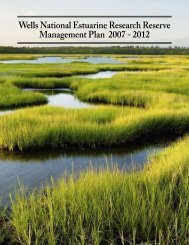inside - Wells National Estuarine Research Reserve
inside - Wells National Estuarine Research Reserve
inside - Wells National Estuarine Research Reserve
You also want an ePaper? Increase the reach of your titles
YUMPU automatically turns print PDFs into web optimized ePapers that Google loves.
spring 2011 volume 28 issue 1<br />
The exhibits were designed by Main Street Design and built by Mystic Scenic Studios with<br />
guidance from an ad hoc committee led by education associate Hannah Wilhelm.<br />
The Changing Landscapes exhibits were funded by generous donations from Charles and<br />
Rebecca Richardson, the Virginia Hodgkins Somers Foundation, and Laudholm Trust, plus a<br />
grant from the <strong>National</strong> Oceanic and Atmospheric Administration.<br />
In planning for the new exhibits, we determined that the historic Laudholm farmhouse<br />
would not be significantly altered. But it was also clear that something needed to be done<br />
to improve the flow through exhibit rooms. The solution was to make a simple change: An<br />
under-used doorway became the new<br />
Visitor Center entrance. The necessary<br />
short walkway and set of steps were<br />
made out of pink granite from right<br />
here in <strong>Wells</strong> by Millenium Granite<br />
Quarry and Stoneworks.<br />
The new exhibits include<br />
touchable features like<br />
wave-worn stones and<br />
a paleo-Indian tool-kit,<br />
an enclosed threedimensional<br />
model of<br />
Laudholm Farms circa<br />
1925, and baskets of toys,<br />
games, puppets, and<br />
books for kids.<br />
7<br />
changing<br />
landscapes<br />
The Wild Landscape<br />
14,000 years ago to 1400s<br />
The story begins with the weight<br />
of a mile-high glacier pressing<br />
down upon what is now the Maine<br />
coast. The end of the last Ice Age<br />
led to colonization of the coastal<br />
landscape by Wabanaki people.<br />
The Economic Landscape<br />
1600s to 1800s<br />
Subsistence lifestyles began to fade<br />
away as Europeans settled in the<br />
region, bringing a market-based<br />
approach to the landscape. The<br />
Industrial Revolution contributed<br />
to a decline in farming throughout<br />
New England.<br />
The Domesticated Landscape<br />
1925<br />
A “gentleman’s farm” flourishes<br />
under unique circumstances as<br />
Laudholm Farms embraces the<br />
progressive farming movement,<br />
but when the Great Depression<br />
strikes a blow the farm never<br />
regains its former glory.<br />
The Protected Landscape<br />
2010 to Present<br />
With roots firmly planted in the<br />
conservation movement and<br />
strengthened by environmental<br />
legislation, people take responsibility<br />
for preserving and protecting<br />
landscapes for future generations.<br />
The <strong>Wells</strong> <strong>Reserve</strong> at Laudholm<br />
models and supports such efforts.




